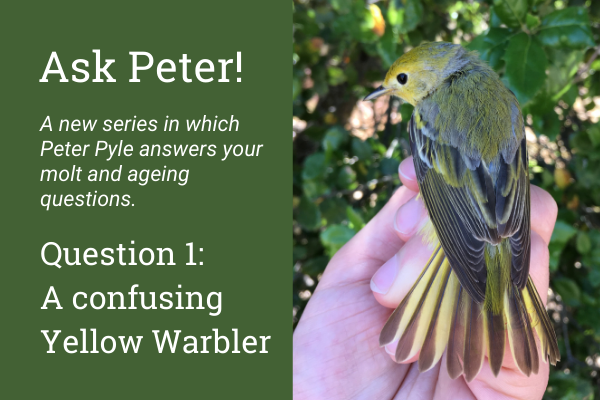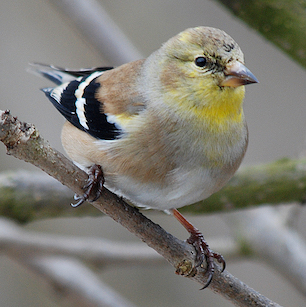If you have a molt/ageing question for Peter, please send good photos, date, and location where the bird was banded/photographed to our communications specialist Meredith Walker at mswalker_AT_birdpop.org. Meredith will compile submissions and about once a month Peter will select one to answer.
These photos were submitted by Julian Tattoni, who banded this Yellow Warbler near Portola Valley, CA on 5/12/2021.
This is the inaugural "Ask Peter" submission for molt study and I can see that this will be a fun and at times challenging exercise all around. Indeed, there are many interesting things about this Yellow Warbler (Setophaga petechia) to consider. When I first opened the images I figured it was of the subspecies S. p. sonorana of the desert Southwest as these can show pale grayish to whitish feather edging like this bird shows among its nape feathers, scapulars and upperwing coverts. Indeed it could be of this subspecies, in which case it would be a spring-overshoot vagrant in Portola Valley, California (near San Jose). But it could also be a more expected subspecies (e.g., S.p. rubiginosa or aestiva) with a feather pigment anomaly, something we see quite frequently in warblers and birds all around. Whichever the case, it may actually help us here in analyzing this bird's molts.
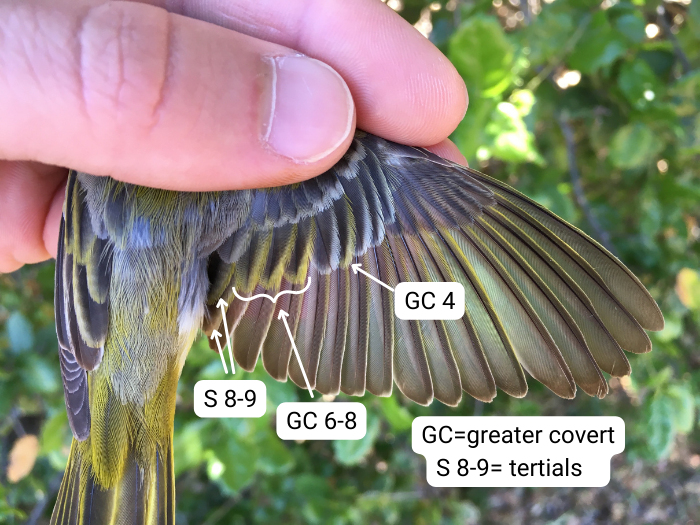
photo by J. Tattoni
Before we get to age and sex let’s consider the Yellow Warbler's molt. This species undergoes a prealternate molt in March-April that can include most to all body feathers, some to all median and greater coverts and usually one or more tertials. Here it appears that the alternate feathers are the yellow-edged ones and that the paler-edged feathers have been retained from a previous generation. Thus, on the right wing, greater coverts 4 and 6-8 (corresponding to the secondaries in numbering) are alternate, as are the inner two tertials, numbered s8-s9 because they are technically the innermost two secondaries. It may be possible that the middle tertial, s8, is formative rather than alternate, but I think it is alternate due to its brightness and yellow edging; the s8 typically is replaced before the s9 within a molt, and this could account for its looking slightly more worn than s9.

photo by J. Tattoni
The left wing, which can be seen in the image of the birds back, shows a similar prealternate molt extent and pattern among greater coverts and tertials, and also appears to show two alternate median coverts as well, not present on the right wing. Note that the replaced feathers are not sequential from the inside, as we see more regularly for replaced formative feathers in hatch-year or second year birds showing molt limits. This has to do with one of the reasons for the prealternate molt in Yellow and other warblers, as a badge to show off for breeding. On the closed wing, the more exposed and visible secondary coverts tend to be in the middle of the tracts, which is where we often see more replacement with more showy alternate feathers.
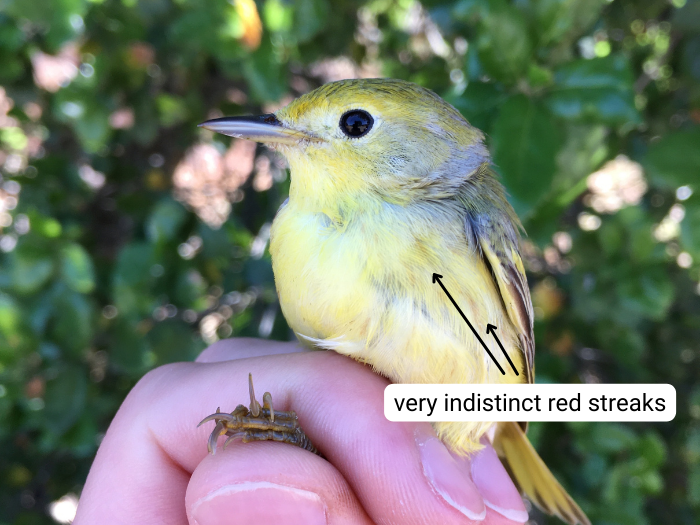
photo by J. Tattoni
OK, for most spring Setophaga warblers it is often best to sex them before ageing them, as body plumage tends to make this easy. I think we are safe calling this a female Yellow Warbler. It is overall quite dull and I can barely see a few red streaks on the breast. Even the dullest SY (second-year) males- or FCA (first cycle alternate) males if you prefer- show brighter plumage including bolder red streaking to the underparts. In this case, however, ageing is somewhat of a challenge as there are some conflicting characters. ASY (after-second-year), or DCA (definitive cycle alternate), females are usually brighter and show more red streaking to the underparts, but there appears to be too much yellow in the outer rectrices for a typical SY (FCA) female. So we have to rely on the condition and the shape of the retained feathers: are they basic or are they formative and juvenile?

photo by J. Tattoni
I stared at this bird for a while, and kept leaning to it being an SY with more yellow than usual in the outer rectrices, as opposed to a dull ASY. Most of the primaries, primary coverts, and rectrices appear rather intermediate between what I would expect of juvenile (on an SY) or basic (on an ASY) female, but the rectrices in particular seem rather pointed and brown (except for the central rectrix that appears to be alternate.) The mixed alternate and pale-edged outer greater coverts make it challenging to assess molt limits between these and the primary coverts, but I think there is enough of a contrast, indicating the retained greater coverts to be formative and the primary coverts to be juvenile, though I've seen much browner and more worn primary coverts on some SY females.
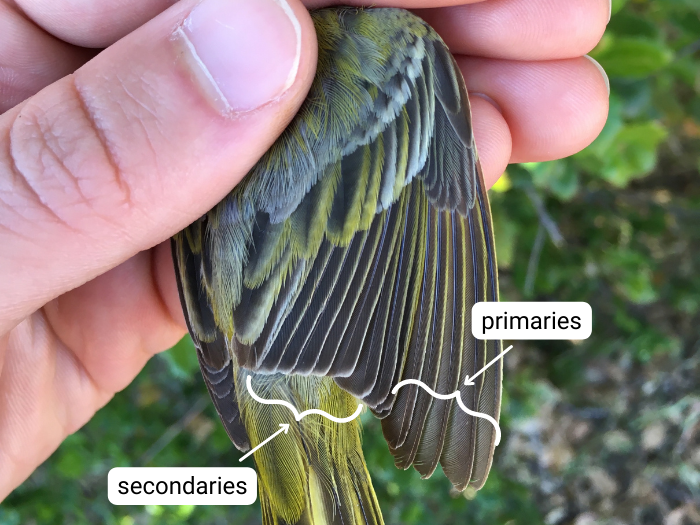
photo by J. Tattoni
I've been studying another ageing character in birds that retain juvenile feathers, "molt clines," or the gradual freshening and at times darkening of feathers as they get replaced sequentially during a molt. Passerines replace primaries outwardly from p1 to p10 and secondaries inwardly from s1 to s6, following replacement of the inner two tertials (s8-s9) which occurs earlier. For birds with protracted molts or those that are exposed to the sun a lot, you can see these molt clines in ASYs that have undergone a complete molt but they are lacking in SYs that retain juvenile feathers, all grown at the same time in the nest. I do not see molt clines in this bird - most easily assessed in the image of the partially opened right wing: all secondaries, especially, seem evenly brown from s1 to s6 and the primaries all seem similar as well. This lack of molt clines was the final piece of the puzzle that makes me confident of SY (FCA) female for this Yellow Warbler.
Increasingly now I'm turning to image catalogues to help with questions on molt, age, sex, and identification, for example regarding hummingbirds. The Cornell Lab of Ornithology's Macaulay Library has become an incredible resource, allowing filtering of images for month of the year, age, sex, location, quality of image, and all sorts of other parameters (even molting). I just checked and there are 110,667 images of Yellow Warblers to check through! With this sort of resource, even with heavy filtering, you can still usually find what you need. For ageing and sexing, there is also Piranga - NatureInstruct: here's their page on Yellow Warblers, a carryover from the MacGill Bird Observatory's age/sex site. If you check out the females, you can see that our bird here matches SY better than ASY in the features mentioned above; e.g., check out the molt cline among the secondaries of the ASY female.


